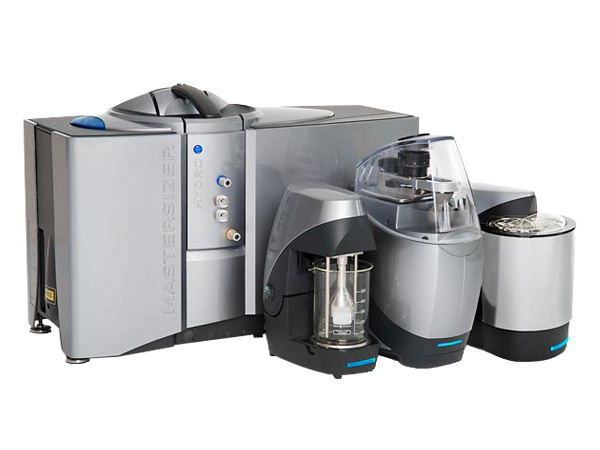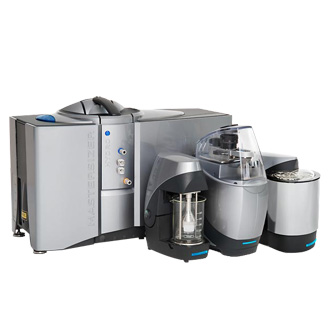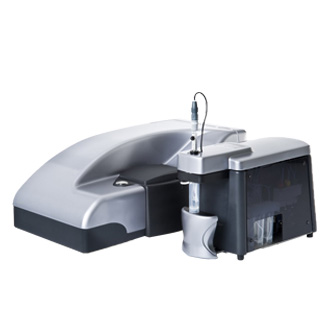Hits: 2456
Particle Size
Hits: 2456

Hits: 2456
Particle Size
Particle size distributions from sub-nanometer to millimeters.
By far the most important physical property of particulate samples is particle size. Measurement of particle size distributions is routinely carried out across a wide range of industries and is often a critical parameter in the manufacture of many products.
Measuring particle size distributions and understanding how they affect your products and processes can be critical to the success of many manufacturing businesses. Malvern Instruments offers leading instrumentation for all types of particle size analysis and characterization from sub-nanometer to millimeters in particle size.
By far the most important physical property of particulate samples is particle size. Measurement of particle size distributions is routinely carried out across a wide range of industries and is often a critical parameter in the manufacture of many products.
Measuring particle size distributions and understanding how they affect your products and processes can be critical to the success of many manufacturing businesses. Malvern Instruments offers leading instrumentation for all types of particle size analysis and characterization from sub-nanometer to millimeters in particle size.

Mastersizer 3000
Smarter particle sizing
The Mastersizer 3000 is the latest generation of the world’s most popular particle sizing instrument. Incorporating expert engineering and applications know-how into every stage of its design, it delivers:
Class-leading particle sizing performance in a compact footprint.
A typical system is made up of three main elements:
Class-leading particle sizing performance in a compact footprint.
- Intuitive software with built-in expertise to ease your workload.
- Flexible reporting to display your data the way you want it.
- Rapid and effective wet dispersion.
- Fast, reliable particle size measurement of fragile and cohesive dry powders.
- Mastersizer know-how throughout, for results you can rely on
A typical system is made up of three main elements:
- Optical bench - A dispersed sample passes though the measurement area of the optical bench, where a laser beam illuminates the particles. A series of detectors then accurately measure the intensity of light scattered by the particles within the sample for both red and blue light wavelengths and over a wide range of angles.
- Sample dispersion units (accessories). Sample dispersion is controlled by a range of wet and dry dispersion units. These ensure the particles are delivered to the measurement area of the optical bench at the correct concentration and in a suitable, stable state of dispersion.
- Instrument software. The Mastersizer 3000 software controls the system during the measurement process and analyzes the scattering data to calculate a particle size distribution. It also provides both instant feedback during method development and expert advice on the quality of the results.

Mastersizer 3000 offers better sensitivity in the size range of 10-1000nm

Zetasizer Nano ZSP
Sensitivity, simplicity, versatility
The Zetasizer Nano ZSP is the world’s highest performance system and particularly suitable for the characterization of proteins and nanoparticles where the highest sensitivity for size and zeta potential measurement is required. It includes a Protein Measurement option for protein mobility measurements.
The system incorporates a two angle particle and molecular size analyzer for the enhanced detection of aggregates and measurement of small or dilute samples, and samples at very low or high concentration using dynamic light scattering with ‘NIBS’ optics. The ZSP also incorporates a zeta potential analyzer that uses electrophoretic light scattering for particles, molecules and surfaces, and a molecular weight analyzer using static light scattering.
Using Non-Invasive Backscatter optics (NIBS) it has significantly better performance than systems using 90 degree scattering optics.
In addition, a microrheology option is available for measuring sample viscosity and viscoelastic properties.
The flow mode option enables the system to be connected to an SEC or an FFF system to use as a detector for the size of proteins or nanoparticles.
A choice of cuvettes are available, from disposable single-use to specific cells for viscous or high concentration samples or measuring the zeta potential of surfaces.
Parameters measured:
Particle and molecule size, translational diffusion, electrophoretic mobility, zeta potential of particles at high and low concentrations, viscosity and viscoelasticity of protein and polymer solutions, concentration, MW, A2, kD.
An optional accessory enables measurement of the zeta potential of solid surfaces.
The system incorporates a two angle particle and molecular size analyzer for the enhanced detection of aggregates and measurement of small or dilute samples, and samples at very low or high concentration using dynamic light scattering with ‘NIBS’ optics. The ZSP also incorporates a zeta potential analyzer that uses electrophoretic light scattering for particles, molecules and surfaces, and a molecular weight analyzer using static light scattering.
Using Non-Invasive Backscatter optics (NIBS) it has significantly better performance than systems using 90 degree scattering optics.
In addition, a microrheology option is available for measuring sample viscosity and viscoelastic properties.
The flow mode option enables the system to be connected to an SEC or an FFF system to use as a detector for the size of proteins or nanoparticles.
A choice of cuvettes are available, from disposable single-use to specific cells for viscous or high concentration samples or measuring the zeta potential of surfaces.
Parameters measured:
Particle and molecule size, translational diffusion, electrophoretic mobility, zeta potential of particles at high and low concentrations, viscosity and viscoelasticity of protein and polymer solutions, concentration, MW, A2, kD.
An optional accessory enables measurement of the zeta potential of solid surfaces.
- Exceptional sensitivity for the zeta potential measurement of proteins and nanoparticles using patented M3-PALS.
- Size measurement from 0.3nm (diameter) to 10 microns using patented NIBS (Non-Invasive Back Scatter) technology.
- Zeta potential of surfaces using accessory cell.
- Molecular weight measurement down to 980Da.
- Microrheology option to measure viscosity and viscoelasticity.
- Outstanding protein size measurement sensitivity, 0.1mg/mL (Lysozyme).
- Sample concentrations from 0.1ppm to 40%w/v.
- Built-in protein calculators, including protein charge, A2, kD, and molecular conformation.
- A ‘Quality Factor’ and ‘Expert Advice System’ gives the confidence of having an expert at your shoulder.
- 21CFR part 11 software option to enable compliance with ER/ES.
- Research software option to give access to further features and analysis algorithms for the light scattering specialist.
- Automation of measurements using an autotitrator option.
- Chromatography detector capability to enable use as a size detector with GPC / SEC or FFF.
- Optical filter option to improve measurements with fluorescent samples
Contact us
Syntech Innovation Co., Ltd.
388/5 Nuanchan Road, Nuanchan,
Buengkum, Bangkok 10230
388/5 Nuanchan Road, Nuanchan,
Buengkum, Bangkok 10230
0 2363 8585 (auto)
0 2363 8595
081 498 9939

2986626
Today
Yesterday
This Month
All days
851
2991
36525
2986626
Your IP: 216.73.216.167
2025-12-19 15:42





